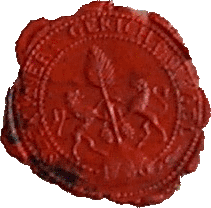 Sekitscher Gerichtssiegel von 1786 |
 Sekitscher Gerichtssiegel von 1786 |
We owe thanks to Mr. Philipp Sandles, for his contributions to this site, who allowed us to publish some of his article here with his friendly permission.
One CD with many additional contributions and documents about the village is being prepared in cooperation with Mr. Philipp Sandles.
I sat in the work room of the Hungarian Land Archives in Budapest and searched for witnesses from that time, to examine the problems of the German settlers, from a swampy and devastated wilderness - almost in the heart of Europe - under the mobilization of all workers to create a fertile cultural land. Before me on the table lay stacks of yellowed pages written in the old familiar Gothic script which we had brought home with us in our school days.
As the dear old acquaintances came forward, the proud and engraved, evenly measured letters, probably still owe their existence to the quill.
What a writing culture that demands legibility as well as beauty. I began tentatively at first to leaf through these old pieces of writing. One cannot grab them greedily; one takes them gently in hand. So as one would want to caress them, one fears that they could disintegrate between the fingers. Inquisitiveness of what these pages have to say is enormous, and with each successful search the demands grew for a new realization again and finally increased to an unquenchable thirst for knowledge, in exhilaration in which one has been timeless, everything about oneself is forgotten. I searched purposefully. On this day I wanted to find as much as possible, everything about the former homeland village. It took time until something was found, until one came upon the word "Szekity" or "Szekits" for the first time. Then finally, there it was. One senses, as the skin alternates warm and cold, and deep inside one feels infinite satisfaction over the new findings. It is expected as one directly raises a priceless valuable treasure.
That paper that one of those settler ancestors held in his hands at the time on which he presented his request in engraved writing, perhaps also lamented about his needs, yes, and perhaps the emperor also held it in his hands deciding on the requests of the petitioners - it is in this moment that one has found more worth than any treasure in this earth. And it drives one to search further with yet greater eagerness. I have searched one whole day, always comprehending more, that one whole life is not enough, to raise all the treasures which slumber there in a 65 kilometer long row of documents. My life has become richer from these treasures and an exciting experience. An excursion in history. Nowhere is it more productive and more beautiful than in the middle of an ancient piece of writing in which one knows that fate of one's forefathers is documented. While one seizes upon such a document, one offers a hand to the settler ancestors and the circles closes and the work is completed. They live on, in us and through our grateful and honorable memory.
Everywhere where the "history writer" goes, whose own crime to the people of the former German folk group was to hush up or hardly justify, he gives arguments and reasons which do not come off like the truth.
One of these in the Yugoslavian "historical writings" spread fist thick lies we want to confront here and place them in the right light. It concerns the claim that the settlement work under Maria Theresia and Joseph II took place for purpose of the Germanization of the European southeast.
Why would one also get German settlers to go to the deserted land after the expulsion of the Turks is adequately well-known. And also well-known is that with the settlement work everything was a Germanization campaign. We can prove this with the following "hand bill" from Emperor Joseph II on the 8th of July 1786…
Is it decreed that an emperor himself bears intentions of Germanization?
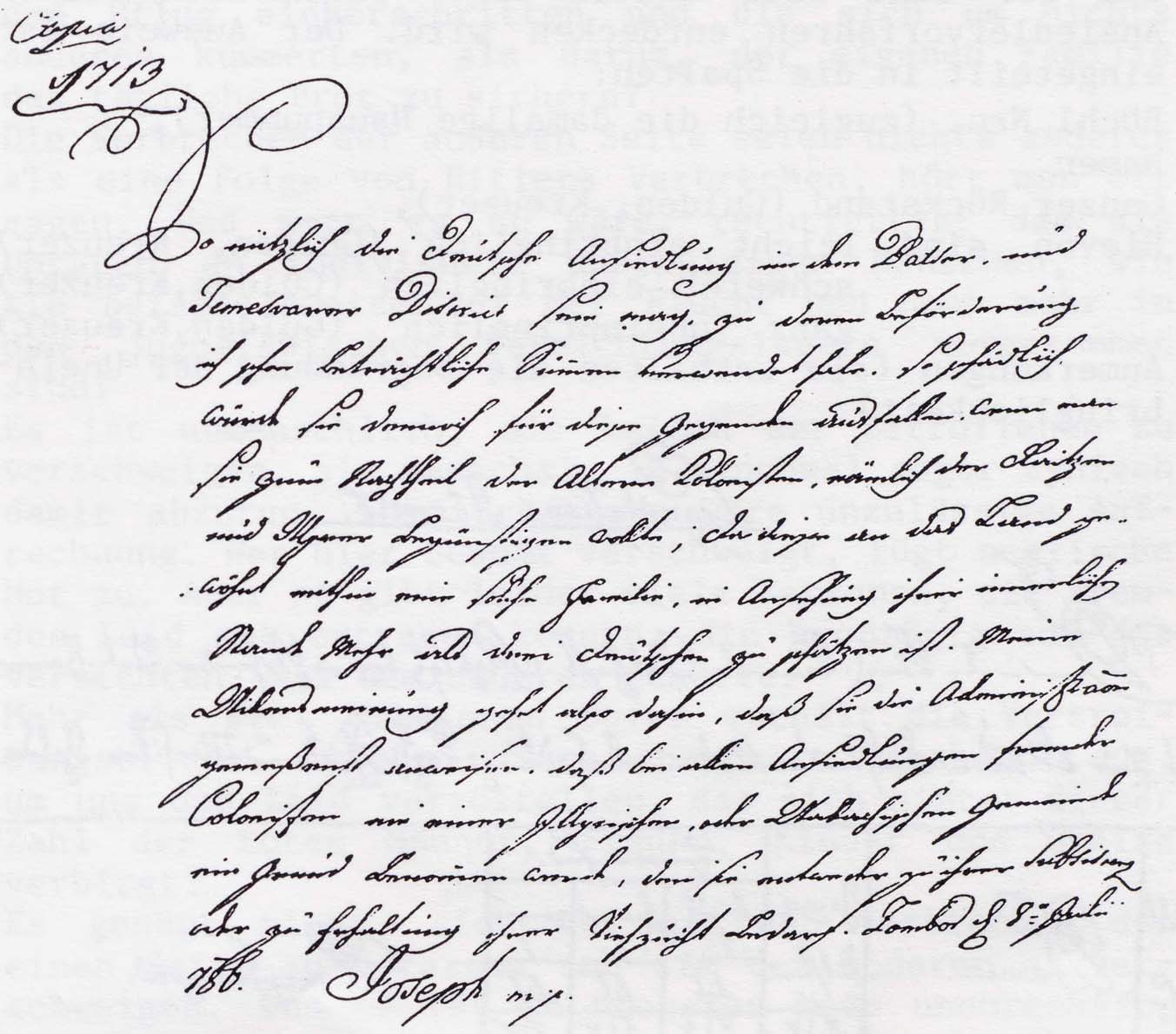 |
Für den des Lesens der gotischen Schrift Unkundigen sei hier der Wortlaut des "Handbilletts" angeführt:
"So nützlich auch die Ansiedlung der Deutschen an sich selbst in dem Batscher und Temeswarer District sein mag, zu deren Beförderung ich schon beträchtliche Summen verwendet habe, so schädlich würde sie dennoch ausfallen, wenn man sie zum Nachteil der älteren Kolonisten, nämlich der Rayzen und Illyrier begünstigen wollte. Da diese an das Land gewohnet, mithin in Ansehung ihrer innerlichen Stärke jede solche Familie mehr als 3 deutsche Familien zu schätzen ist. Meine Willensmeinung gehet also dahin, daß Sie die Administration gemessenst anweisen, daß bei allen Ansiedlungen fremder Kolonisten nie einer Illyrischen oder Walachischen Gemeinde ein Grund benommen werde, den sie entweder zur Subsistenz oder zur Erhaltung ihrer Viehzucht bedarf. Zombor,den
8.Juli 1786. Joseph m.p."
Your Imperial and Royal Majesty I most humbly
have to inform you what happened with mother and my siblings, who were
transferred from the Empire to here, and until this day we have been living for
each other; but as I can not be compared to one of my step brothers I am
presenting myself at the Impopulation’s office representative, who at the
moment can not give me any answers; but since it is no longer possible for me
to live with my step brother, and at the same time it can not be expected of
myself to live with constant arguing and quarreling, by which actions our
Almighty will be insulted. At the same time I most humbly beg your Imperial and
Royal Majesty through the Royal Bacs Administration office to grant me not only
a homestead but also a residential dwelling with stables, farm animals and
whatever is necessary, as I am about to be married. With my deepest humility to
your Roman Imperial and Royal Apostolic Majesty,
Szekics July 5.th 786
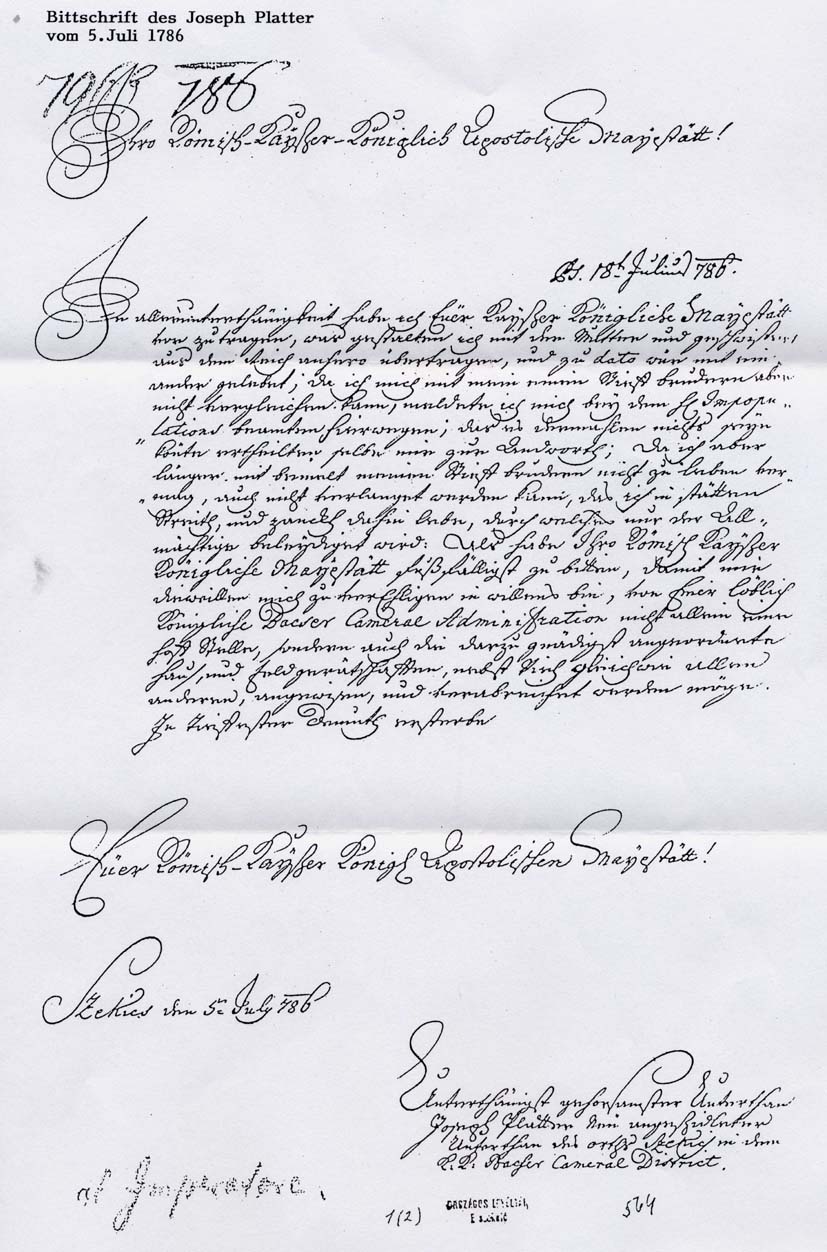 |
The settler of Emperor Josef's time did not always have a bed of roses with the Kameral properties in the Batschka. In the beginning there were some setbacks, some needs, which were helped through state support. One such "immediate assistance office" was the "Bajaer Verpflegsmagazin" (Baja's Food Warehouse), that helped settlers with properties of all kinds. The settler was indeed obliged to refund these rewards, livestock funds, and utensils fund at a given time. Also these refunds could not take place in all cases, simply because the required financial middle fell. One so-called "Liquidations-Ausweis" (liquidations certificate) (Court Chamber Archive of Vienna, Hungarian Chamber, red no. 99, subdivision 1, films 227 and 228) showed us the state of the arrears of the Sekitsch citizen at the end of October 1802. This certificate was drawn up on the occasion of the transfer of all Batschka Kameral villages to the "Privileged Batschka Canal and Shipping Company." All assets and liabilities were included in it, which also had to count the arrears of the colonists. In the certificate not all inhabitants of Sekitsch at the time were included, but only those who still had to settle such arrears.
The certificate is divided into these columns:
booklet number (same as house number at the time), names, complete arrears (Guilder, Kreuzer), then easily profitable (Guilder, Kreuzer),
difficultly profitable (Guilder, Kreuzer), completely unprofitable (Guilder, Kreuzer), and remarks (they contained the reason for the unprofitability).
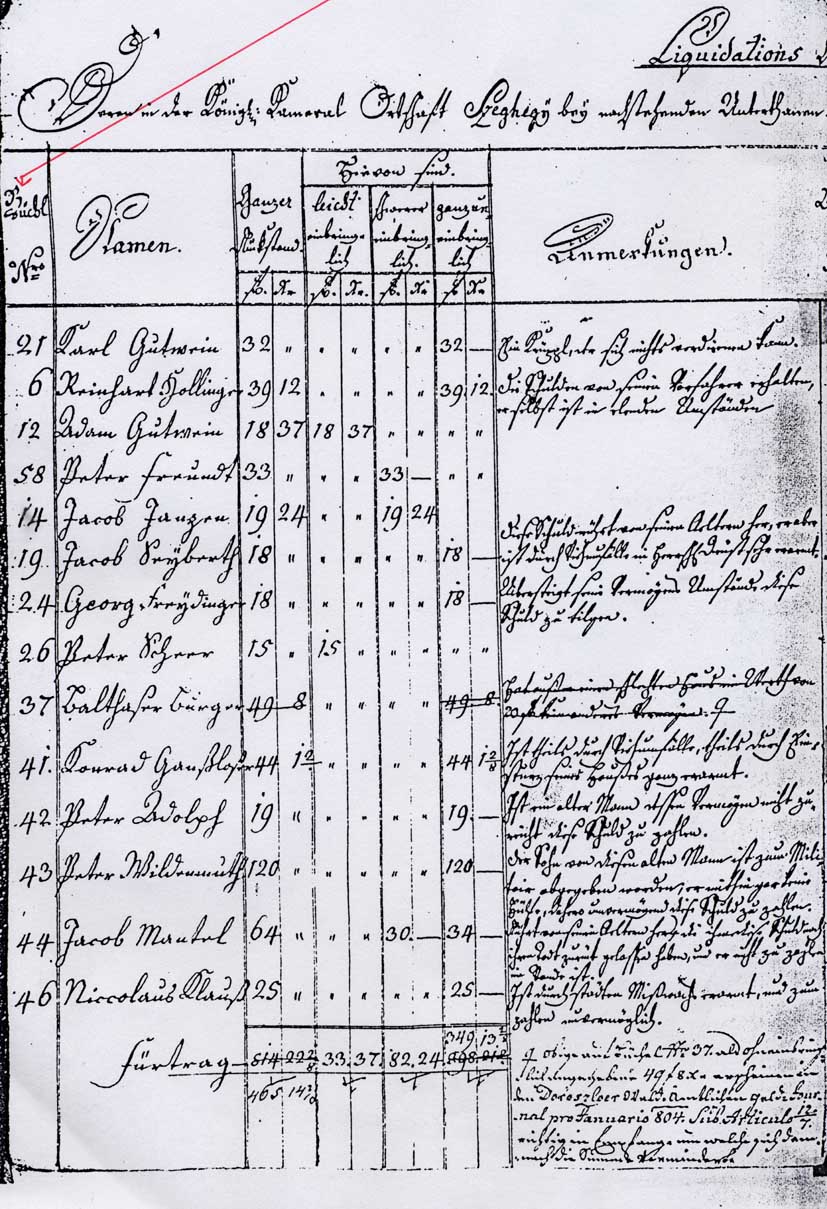 |
The Munich newspaper "Donauschwäbische Forschungs- und Lehrblätter" (Donauschwaben Research and Teaching Paper), published quarterly, from September 1982 contains an article by Oskar Feldtänzer about "Die Ansiedlung des Jahres 1786 und die Somborer Administration" (The Settlement of the Year 1786 and the Sombor Administration), contained information about our homeland village of Sekitsch which should be known to all of our countrymen. From original documents of the Sombor administration which are found in the Hungarian State Archives in Budapest, produced many facts unknown up to now, that our homeland village, just like Bulkes and Kleinker, originally was hardly planned as a settlement village and its existence owed to a fluke of nature.
On the 8th of December 1785 the settlement office in Sombor worked out an operation plan for the settlement in the year 1786. Contained in this plan among other things were the so-called dislocation tables which directed the distribution of the colonists in the settled villages. After that the settlement families were planned for Kula, Kuczura, Szivacz, Schove, Pivnicza, Lality, Bezdan, Bresztovacz, Raczmilitics, Kernaya, Csonoplya, Veprovacz, Almäs, Kattymär, Cseeb, Szilbäs, Parabuty, and Obravacz (spelling, of the village name according to the document). Szekity was not in this table, so it was planned for this settlement. Yet what was the reason that Sekitsch came to be a settlement? We cite Feldtänzer:
"In the course of the spring of 1786 an alarming announcement was made by the district administrators of the Sombor, Kula, and Palanka Districts that a large part of the Batschka was flooded from the ground water. Not only were a large part of the winter seeds under water, but also the cultivation of the summer grounds could not be begun. In some villages even a considerable number of earth packed homes collapsed, so the feasibility of the operation plans was seriously placed in question, so it needed short-term fundamental changes to put up the planned number of 1,303 German families in settlements. The leader of the Batschka Kameral administration, governor's advisor Michael of Urmeny, took the time to urge the immediate trip to visit the affected region to ascertain the extent of the flooding and initiate the necessary remedial measures."
These remedial measures are in it, that among other things a new dislocation plan was worked out so the intended colonial families for the above named villages were completely or partially "redirected". Let the author of our article again speak to us:
"Completely cancelled were: 104 families for Kutzura94 for Pivnitza, 40 for Lalitsch, 31 for Kattymar, 25 for Tscheb, 52 for Szilbas, 23 for Parabutsch, 44 for Obrowatz, and 62 families for Temerin. In Miletitsch the house lots were reduced from 43 to 30, Tschonopl from 140 to 108, Almasch from 98 to 60, and Siwatz from 144 to 120. To make up for this the following three areas were newly planned for the relocation of these families: SEKITSCH with 160 families, Klein-Ker with 191 families, and Bulkes with 230 families."
So our homeland village of Sekitsch owes its existence to a whim of nature as the document shows. For us it awoke the realization that natural catastrophe could have one exception of something good. Without that flooding there probably would have been no Sekitsch and with it no Sekitsch people, then in the year 1787 it was practically copied by Jarek, the last settlement year. If nature had not played her hand at the time, we would probably be a little sad today. Where then should we be proud, if not for our lovable homeland village of Sekitsch!
Besides that, it was completely obvious from the documents that the date of the distribution of the Sekitsch homes on the 5th of May 1786 can not be completely right because up to this point they were not built yet. The planned date for the actual settlement was intended to be a firm date. For Sekitsch there was no such date. Our sources show otherwise.
The 160 Evangelical families, who should be settled in Sekitsch had to remain in the waiting place for the time being as the surveying of this area was still not carried out.
Completely as a side note we finally learn still from the documents that the office writer SCHRAMM at the settlement office was transferred to Sekitsch for disciplinary reasons because of disregard of his obligation to maintain confidentiality of the Kameral administration in Sombor. Our Sekitsch as "penal colony", whose idea!
Under the title "Sekitsch - A Whim of Nature" I wrote about the settlement history of our homeland village. The reason that Sekitsch was settled with German colonists instead of Hungarians as originally planned, was that the high ground water triggered flooding in the Batschka.
A short time ago I received the illustrated map of the Batschka in this article in which the dark places distinguished the most severely affected regions. This map served the Kameral engineer of the time, Josef Kiss, as the foundation for the realization by which he recommended and then carried out the digging of the Franzen Canal. Revealing for us is that the map by Kiss added reason for his plan for the canal construction.
From there the text is difficult to read, so I give it completely in his words here:
A: Proof - The complete diverting of the Szivacz swamp towards Verbasz as wel as Szivacz, Cservenka, and Kula but all to Pallanka found 20 villages completely dry and free from flooding.
Sentence 1 - The Danube flows from Apatin upwards towards Novosello almost in a straight direction.
Sentence 2 - The Theiß from Petrovosello flows almost in the same direction with the Danube up towards Titel, which is one proof of the convex surface of the earth, and the earth's realm between these two rivers have one same direction.
Sentence 3 - Szivicz stands almost in a parallel line with Apatin and Petrovoszello and Pallanka with Novosello and Titel, following the natural conclusion that as the Danube flows from Apatin to Novoszello and the Theiß from Petrovoszello to Titel, on the same kind from Szivacz it spread out, and already almost to the sea the swamp to be able to do the natural position of the earth's service flowed towards Pallanka and the surface region.
From these sentences is the natural conclusion that by complete drainage (draining) of the Siwatz swamp all by the way of Siwatz to Palanka finds 20 villages to be free from flooding.
B: Proof - Through the experience that the Szivacz swamp flowed to Pallanka. By the rise of the Szivacz swamp was at first noticed flowing in Veprovacz, from Veprovacz the water seeped to Filipova, from Veprovacz and Filipova to Kersztur, from the above named three villages the flooding spread out towards Hodcsagh, Lality, Torza, and Kuczura, from these villages it flowed towards Parabuty-Pivnicza and Despot Sz. Ivan, from these villages towards Paraga-Szilbas, from this towards Tovarisova and Gaidobra, from these to Obrobacz and Cseb, and from these it seeped to Pallanka. Consequently this proves again the conclusion that the Szivacz swamp flowing to Pallanka and totally draining the Szivacz swamp frees all of the above named villages from flooding.
C: Proof - That the drainage canal from Szivacz to Földvär is the best direction to have the diversion. The Danube flows from Pallanka towards Titel, parallel to the canal dug from Szivacz to Verbasz and from Verbasz to Földär. Consequently it is by virtue of this direction as well as the canals already dug up to now proves the best direction for draining was made.
Note To fulfill the above advertised advantage the canals had to have their whole depth with nothing diminished.
Explanation: All this which was not one of them to the Batschka Cameral rule, is darkly laid out, the villages are marked in red, and those underlined which have a rapid river as proven in A., B., and C.
seal Neu Verbasz, 1st of August 1787.
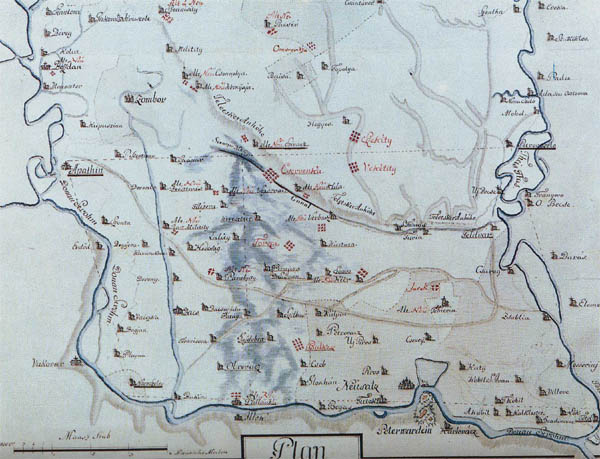 |
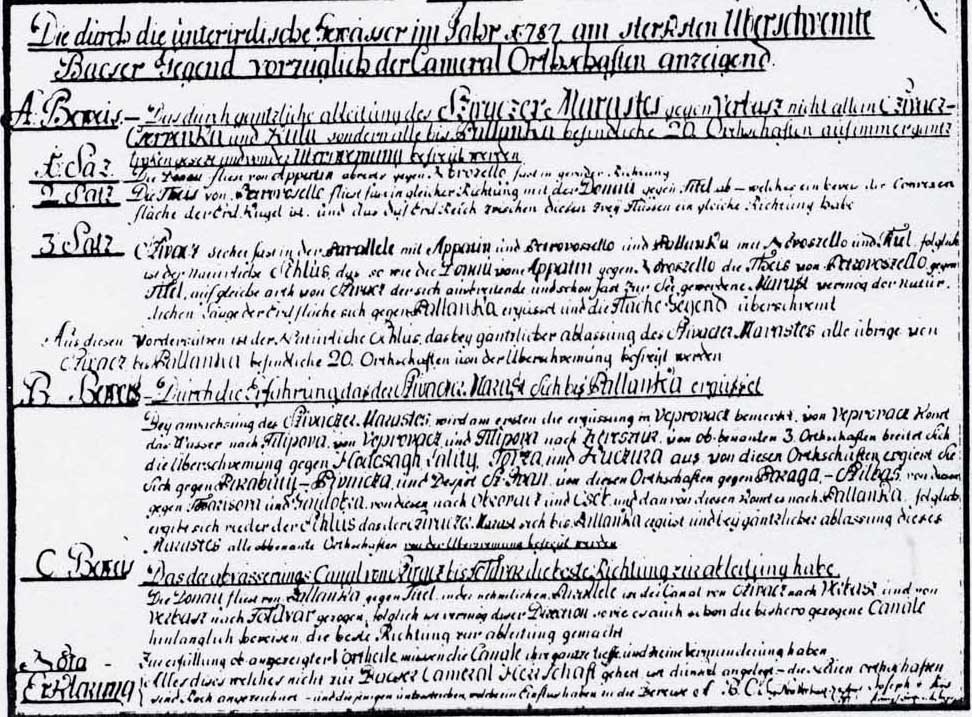 |
Johann Jauß wrote in his book "Szeghegy im ersten Jahrhundert seines Bestandes" (Szeghegy in the first Century of its Existance) on page 23:
"It is demonstrable that on the 4th of May, 1786 all of the main families who were destined to be settled in Szeghegy, were quartered in the surrounding area and appointed to Szeghegy. It may not be forgotten that the homes in Szeghegy were already built in the fall of 1785 and were quite finished. The whole .. settlement commission .. had turned up for this day in Szeghegy… and in accordance with the numbers on the settlement booklets the homes were distributed and assigned."
Johann Jauß wrote: "It is demonstrable…" Yet he did not introduce any proof. Without wanting to diminish his one time most well-earned merit about the hundred year history of our homeland village of Sekitsch and in respectful acknowledgement of his valuable contributions to the total Donauschwaben historical writing in the first hundred years of the Emperor Josef's settlement, I want to answer the basic question of the correctness of the above date (4th of May, 1786) with the help of valuable documents. It may be right that the main families were ordered to Sekitsch on the date mentioned and that the distribution of homes followed - as Jauß wrote. Yet it could not be "demonstrated" because they were still not built. In his visitation report of 21 August 1786 Peter Graf Revay (council member of the state office holders in Budapest) wrote about his inspection trip:
"This district (Szekity, note: PS) was actually decided in the beginning after the operations plan by the 8th of December 1785, but after that German empire immigrants should be settled as much as possible, and administrator (v. Ürmenyi, note: PS) first after the planned visitation, and since the time the increase in settlers was necessary, as is still the case for the settlement today, so the homes could not be built earlier than the month of July."
The visitation report has a table added about the:
"condition of the settlement homes built in the Batschka district, as such would be found from the 26th to the 29th of June 1786."
After that the following were produced for Szekity (Sekitsch):
| number applied to be constructed: | 228 homes | |
| completely stamped out: | 30 homes | |
| in the process of being stamped: | 12 homes | |
| still unstarted: | 186 homes |
| with roof trusses and covered up: | 6 homes | |
| with roof trusses, but uncovered | 24 homes |
After the event there were at least 6 homes on the 4th of May, 1786 which were already finished at the time - could be assigned and moved into. But perhaps not a single one was finished?
We know with certainty that Sekitsch was settled in 1786. The same document gives us information about the approximate entry of the colonists into their homes:
"…so the construction of the homes could not be done earlier than the month of July, still this was used a lot, so that the construction stopped on the existing colonial villages in the district, the united strength of the construction of this colony was used (Szekity, note: PS); This order that was met left me with some hope that the construction of these villages may be completed by September at the latest."
And yet another document started doubt as to the date of 4th of May 1786. The "protocol of the Sombor Kameral administration, the settlement concerned the year 1786", by the 5th of May, 1786, named the day on which the colonists were assigned to their settlement village for the purpose of handing over the homes:
| 15th of May | Bezdan | |
| 16th of May | Csonoplya | |
| 17th of May | Kernaya | |
| 18th of May | Veprovacz | |
| 19th of May | Racz Milititcs | |
| 22nd and 24th of May | Bulkesz and Palanka | |
| 25th of May | Soove | |
| 26th and 27th of May | Kis-Keer | |
| 29th of May | Kula | |
| 30th and 31st of May | Szivacz | |
| 1st and 2nd of June | Almas |
The protocol then continued:
"Now the 160 Evangelical families who wanted to go to Szekity, the destination they applied for, still could not come while the surveying as well as those internal and external grounds still did not exist, so in the meantime they should be moved to quarters in Neu Verbasz…
But they should be transported to their settlement as soon as possible, so…
2. the administrator Strassey will carry out, without staying himself, to order on the Szekity district, and draft a design where to build the village, and how to properly assign so that those who are intended to winter seed are able to plow and cultivate in time. Then with this design…
3. Kameral engineer von Kis together with the dislocation table to communicate, so they could begin the necessary house construction.
So we are certainly not amiss in the acceptance that the settlers of Sekitsch could move into their houses at the end of July at the earliest and by the end of September 1786 at the latest.
Note from Brigitte and Gunther Wolf to this article:
The death of Adam Roth, who is shown on the 1st of November 1786 with the note "quartered in N.157" left the impression that the settlement of Sekitsch still did not end until November.
The settlement of the Batschka through the Turkish rule (1526-1717) experienced an interruption. The settlements which existed before the Turkish invasion have almost completely disappeared. After the Turks were driven out the countryside of the Batschka returned to its natural state. Now with lengthy laborious work it has transformed into a cultivated land.
After the Turks were driven out only the thatched huts ("turgurias") existed at first, of which only the roof lay above the earth floor. The maps of the Batschka cameral administration from the years 1762-64 showed such huts on the borders. Those few settlements which survived the Turkish times were still the so-called "Haufendörfer" (irregular conglomerate villages) in the 1780's. In the Batschka the houses stood pushed together narrow and irregularly in these villages. The systematic newly established villages after the expulsion of the Turks were first of all street villages with large spacious farms. The geometric village layout first came about in 1760. The regular village layout displaced the old form of irregular villages. They also brought a regular corridor form. Those in the setting of the Swabian migration settlement villages were separated by the land belonging to someone. They lay as a rule in the middle of the border, to make possible everywhere and equally favorable access.
The Batschka village, a rural settlement, was in its position, form, and size determined by the agricultural work. They decided on a one family house. Responsibility for the engineer planning for Emperor Josef's villages was the Kameral engineer Josef Kiss. The principles for the erection of the villages were:
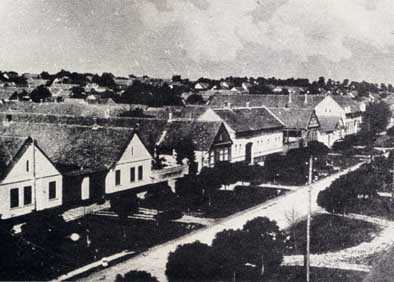
>Main Street in the direction of Hegyes |
The colonial villages in the Batschka were "chessboard villages." On the long village streets stood the decorated homes with their gable side turned towards the street. In front of the homes ran the plastered sidewalks and in front of them stood the mulberry, acacia, lime, and chestnut trees. Then came the street ditches and in the middle, after about a year's time the dusty and muddy wide drive way. In the center of the village stood the church and in the immediate neighborhood was the community house. |
The main streets were up to 45 meters wide, the side streets were up to 23 meters. Emperor Josef's new villages were street villages. They were laid out on the most important streets and had as a rule three parallel running long streets and several cross (Quer- or Kreuz) streets. Through the center long street (main street) ran the major highway. In the village neighborhood lay frequently vineyards and wine cellars in or by them. Each village had it's "Hutweide" (meadow), on which the herds of livestock grazed. The farmers had at their disposal on the outer half of the village on the border above fields, on which the "Sallasche" (manor) stood. They usually stood in the middle of the field.
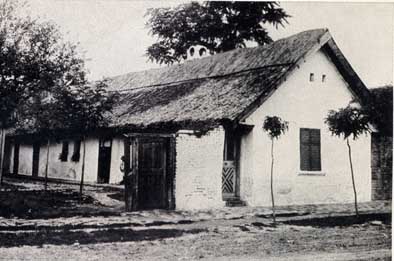 |
The settlement homes were built uniformly after the plans from Vienna. The Theresian settlement house consisted of either a room and a kitchen (type A) or room, kitchen, and chamber (type B) with 3 doors and 3 windows. The Josefinish house was larger. It was 11 fathoms long, and 8 feet (shoes) high and consisted of a room, kitchen, and chamber, and had a stable (1 fathom = 1.89 meters, 1 foot = 0.316 meters). |
The settlement houses were stamped with clay and were covered with thatch. For 10 homes came provided with a well built with bricks and with a pump handle to which a scoop pole hung with a scoop bucket. The well stand was made of wood, and later it was bricked up. For the acquisition of the clay for the stamping of the house the so-called ground hole, which was frequently filled with water, remained at the edge of the village. The three-cornered gable of the farmhouse was already built with baked stone before 1848. It spruced up the house and gave it so much more respect.
Often the year's date of the erection and the name or initials of the owner were applied to the surface of the gable with mortar. About 1850 there were richly decorated round gables with old rustic symbols.
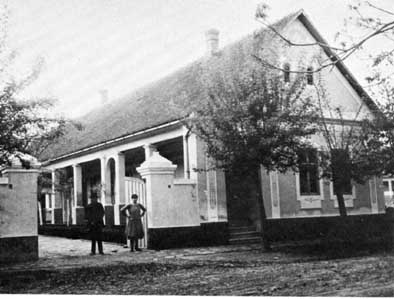
long house |
With the increased prosperity of the population different new house types developed from the settlement house: the long house, the cross (Quer) house, and the corner house. The long house stood with the gable to the street. It had the "house entrance" (arbor entrance) on the yard side under the overhanging roof which was supported with walls, arches, or pillars. Those walls were whitewashed or painted with flower motifs. The floor was covered with stone slabs. In front of the arbor entrance grapevines frequently climbed high up to the roof gutter and adorned the entrance so it gave the appearance of an arbor. | |
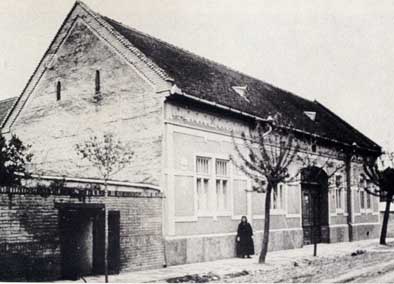
cross house |
A cross house later built on to the long house stood parallel to the street and frequently took up the whole piece of ground. It then had in the middle a curved gate with a roof covered entrance. The cross house documented the prosperity of the owners and was a status symbol. But it's purpose was also for the creation of additional living space, mostly for the grown up and married children. The corner house stood on the street corners. Both of its parts ran parallel to the respective street. |
These new house types were already made of brick or Kotstein (sandstone?) and had tile roofs. They were also extended with wider stables and barns and often had a summer kitchen. In the rich Donauschwaben settlements there were finally already homes with up to 12 rooms. The yard enclosure of the house was in most cases in three parts. In the front of the yard there was a flower garden, the middle yard was reserved for the work space (shed, stables, etc.), and the back yard contained the work garden (fruits and vegetables). The parts were separated from each other with fences. Almost every house had its parade room (extra room) with the high bed full of pillows and the bins and wardrobes full of underwear and clothing. The trousseau was to be on display. Living was in the kitchen and chamber. In the kitchen stood the "Sparherd" (stove), on which cooking was done. In the chamber stood the beds mostly along the wall. The normal bed consisted of a straw sack, then a feather underbed, sheet, pillows, and covers (bedding). Over it lay the curtain-sheet (with trimming at the top) and the blanket (bedspread). The water was supplied by wells, of which there were different kinds.